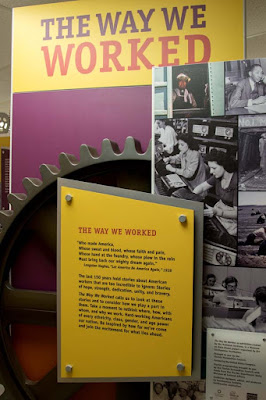We never heard of the
Smithsonian’s Museum on Main Street until 2014. This program serves small
communities with traveling exhibits and educational programs. We happened to
visit Cedar Key in October, 2014 and saw fliers for an exhibit called “The Way
We Worked”. The compact exhibit, featuring photography from the National Archives
and Records Administration of working Americans through 150 years, takes only
about 30 – 45 minutes to peruse. Concise wording explains each section, and
guides the viewer through the history of working men and women in this country.
The local venue also does its own exhibit of the way they worked in their area.
In Cedar Key, we saw a wonderful representation and explanation of the clam
farming for which they are justly famous. It impressed us so much we advised a
number of people we know to check it out if it arrived in their area.
Now, over two years
later, we discovered that the exhibit is still touring. Last week we visited
the Pioneer Florida Museum and Village, and went through the exhibit again. We
enjoyed it just as much as the first time, and noticed things we hadn’t before.
This time I was struck by the number of the jobs which over the years which
have been automated out of existence, the photograph of a telephone switching
board with dozens of operators, for example. I also noticed more closely the
sign below:
I liked the recognition
of all the unpaid work people do. Surveys conclude that having a job is the
number one social value in our American culture. Many years ago while attending
meetings in a European country, a colleague from that country commented that
Americans always focus on a person’s work when they meet him. “What do you do?”
still tends to be one of the initial questions we ask when first meeting
someone. As a culture, our work continues to be part of how we define and
present ourselves. Whether that job is a vocation, avocation, paid or unpaid,
it matters to the person and to those who benefit by the work. I suspect a lot
of what we enjoyed when touring the Pioneer Florida Museum was the result of
volunteer work.
This time we learned
about jobs from the past here in Pasco County, FL. Citrus farming plays a big
role in our past, as does fishing in the coastal area.
If you get the
opportunity to see this exhibit, I highly recommend it.




No comments:
Post a Comment